A proper cut requires a very sharp knife with a straight edge. The cut should be clean and smooth with no fibres on either side. The cut should be done in one movement. Except from top cleft grafting, the technique implies fit cuts of stock and scion respectively. A cutting angle of ≈ 20° for splice, whip or wedge graft is suitable. It is important that the cut angle is the same in stock and scion since a different angle of two cuts will result in a bend junction.
The size of the scion and the root stock is compared in order to find fit pairs. The place of cutting at the root stock can also be adjusted to fit the size of the scion.
When putting the two parts together they should fit so that there is as little gaps and exposed wood and cambium on either side as possible. Some examples of cuts and joints in top cleft grafting are shown at next page.
 | 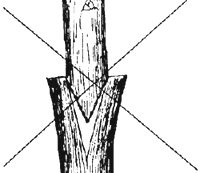 | 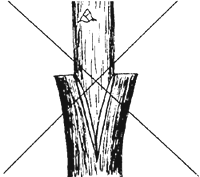 |
| Ideal fit cut with angle ≈ 20° | Too short cut of the scion | Concave cut of the scion |
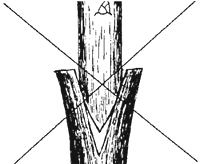 | 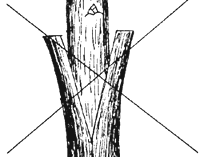 |  |
| Convex cut of the scion | Scion inserted too deep into the cleft. | Scion inserted too shallow into the cut. |
The two joined parts should have maximum cambial contact. If the root stock has a bigger diameter than the scion, the joint should fit in one side only.
A scion should never have larger diameter than the root stock. An example of a joint in splice grafting where the scion is considerably smaller than the stock is shown below.
 | 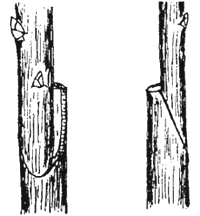 | 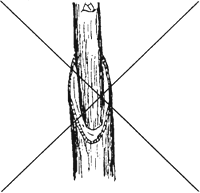 |
| Cross section of stem, showing cambium, bark pith and wood. | Uneven joint correctly fit: The cambial layers at one side are joined in order to maximize cambial contact. | Uneven joint incorrectly fit: The two parts will not “take” since there is little or no cambial contact. |
When the two parts are brought together, grafting tape or string is wrapped around the joint. The wrapping should be tight and completely cover the joint. It serves 3 purposes:
It keeps the two parts together in a fixed position until they have grown together.
It restricts evaporation from the cut.
It excludes water and air, and entry of fungi at the joint.
Sometimes grafting wax or vaseline is used together with the wrapping material in order to help sealing the union. The wax can be a cold type or a hot type. The hot type solidifies upon cooling and must be reheated just before use. It is important that the hot type wax be at the right temperature when it is used. If the wax is boiling, it will injure the plant tissue; if the wax is too cool, it will not flow easily into all the crevices in the bark, thus leaving openings for the entrance of air, water and fungi spores.
The hot type grafting wax can be home-made from basic ingredients of beewax, resin and tallow or other fat. The important characters of a grafting wax are the following:
Melting point: The melting point should be so low that the melted wax will not damage the plant tissue but so high that it will not melt when exposed to extreme field themperatures.
Viscosity: The wax should have a consistence so that it will be thin flowing and applicable in a wide temperature range, e.g. 50–70°C.
There are several techniques on grafting. The various methods are used in different plant material and for different purposes. However, often the use is according to personal preference of individual nurserymen, some preferring one type, others another.
The main types used in forest tree breeding are shown below:
splice graft | ||
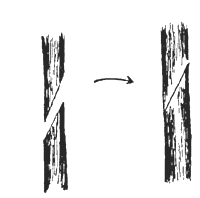 | Useful in grafting small plant material, with a pithy stem or wood that is not flexible enough to permit a tight fit when a tongue is made as in the whip graft. Not much used in forestry. Technique: Simple technique that consists of only one slant cut of stock and scion, respectively. | |
whip graft | ||
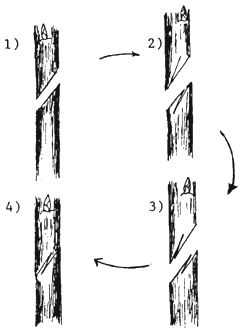 | Useful for top grafting of small plant material, about 6–12 mm in diameter. | |
| Technique: | ||
| 1. | The first cut is the same as in splice graft. | |
| 2. | A second cut is made starting ⅓ of the distance from the tip to the base of the first cut on both stock and scion. This cut should not just split the grain of the wood but should follow along under the first cut, tending to parallel it. | |
| 3. | The two parts are pulled apart. | |
| 4. | The cut of the two parts are slipped together so that the tongues interlock. | |
Top cleft and wedge graft | ||
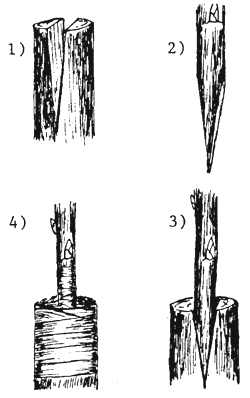 | Top cleft is used for the same type of material as splice and whip graft; wedge graft is used for bigger materials. | |
| Technique: | ||
| 1. | The stock is first cut straight and after that a perpendicular cut is made in the center of the stump. For bigger material, a wedge is cut in the top of the stump. | |
| 2. | The scion is cut in the form of a wedge (for big material, similar to that of the stock). | |
| 3. | The scion is inserted in the cut made in the stock. In case the stock is of bigger diameter, the cambium should fit at one side only. | |
| 4. | Wrapping and possible waxing. | |
Side Graft | ||
| The method is used when the diameter of the stock is considerably bigger than the diameter of the scion or where top grafting is not applicable. Used for broad-leafed evergreen species. Technique: Various methods; the principle is that the top of the stock is not cut until the two grafted parts have united. Two methods are shown below: | ||
Veneer graft | ||
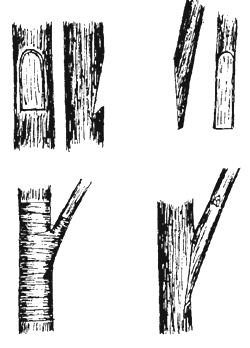 | Technique: | |
| 1. | A slanting cut is made in the stock which penetrates as far as the xylem and the piece is removed. | |
| 2. | The scion is prepared so that the cut fits that in the stock. | |
| 3. | The two parts are joined so that the two cambiums fit (at least at one side). | |
| 4. | Wrapping and possible waxing. | |
| 5. | The top of the stock is cut off just above the scion after the two parts have united. | |
Side-Tongue graft | ||
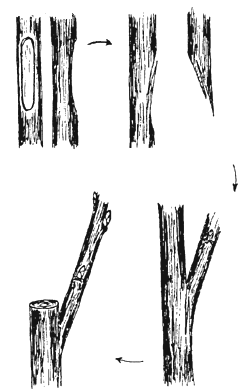 | Techniques: | |
| 1. | A piece of bark and wood ca. ¼ of the stem is cut along one side of the stock. | |
| 2. | A thin downward cut is made forming a thin tongue. | |
| 3. | A long cut is made at the scion; a second cut is made under the first forming a thin tongue as in the root stock. | |
| 4. | The scion is slipped into the cut in the stock, the tongues interlocking so that the cambium matches at least at one side. | |
| 5. | Tying and possible waxing. | |
| 6. | The top of the stock is cut off just above the scion after the two parts have united. | |
Approach grafting with water bottle | ||
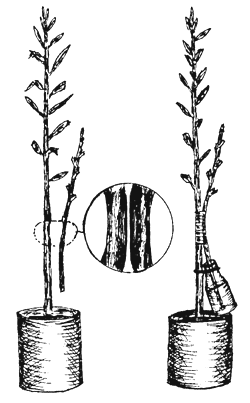 | A variation of side grafting used when there are problems with dessication of the scion. Bottle grafting has been used successfully in e.g. Eucalyptus spp. | |
| Technique: | ||
| 1. | A cut is made on the side to about ⅓ of the diameter of the scion and the stock respectively (best where there is a natural bend). | |
| 2. | The two parts are united so that there is maximum cambial contact. | |
| 3. | Tying and possible waxing. | |
| 4. | The end of the scion is put in a bottle with water, which is attached to the stock. | |
| 5. | When united, the top of the stock and the end of the scion below the graft union is cut. | |
Note: The scions used must be longer than in other grafting methods in order to reach the water in the bottle. | ||
| The water should be changed regularly, in order to avoid alga formation, and the bottle refilled when necessary. | ||